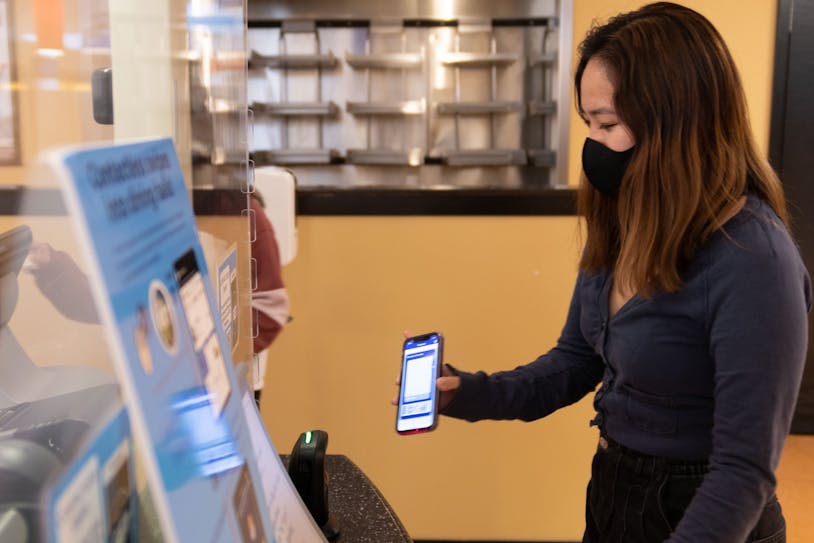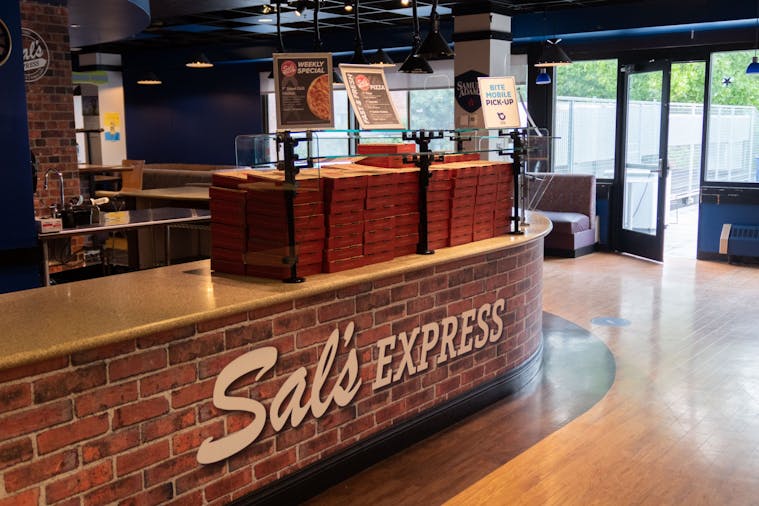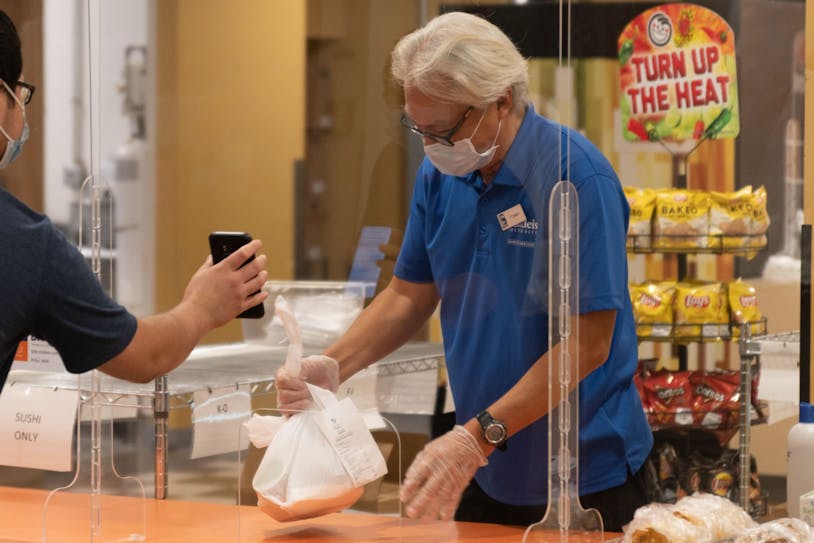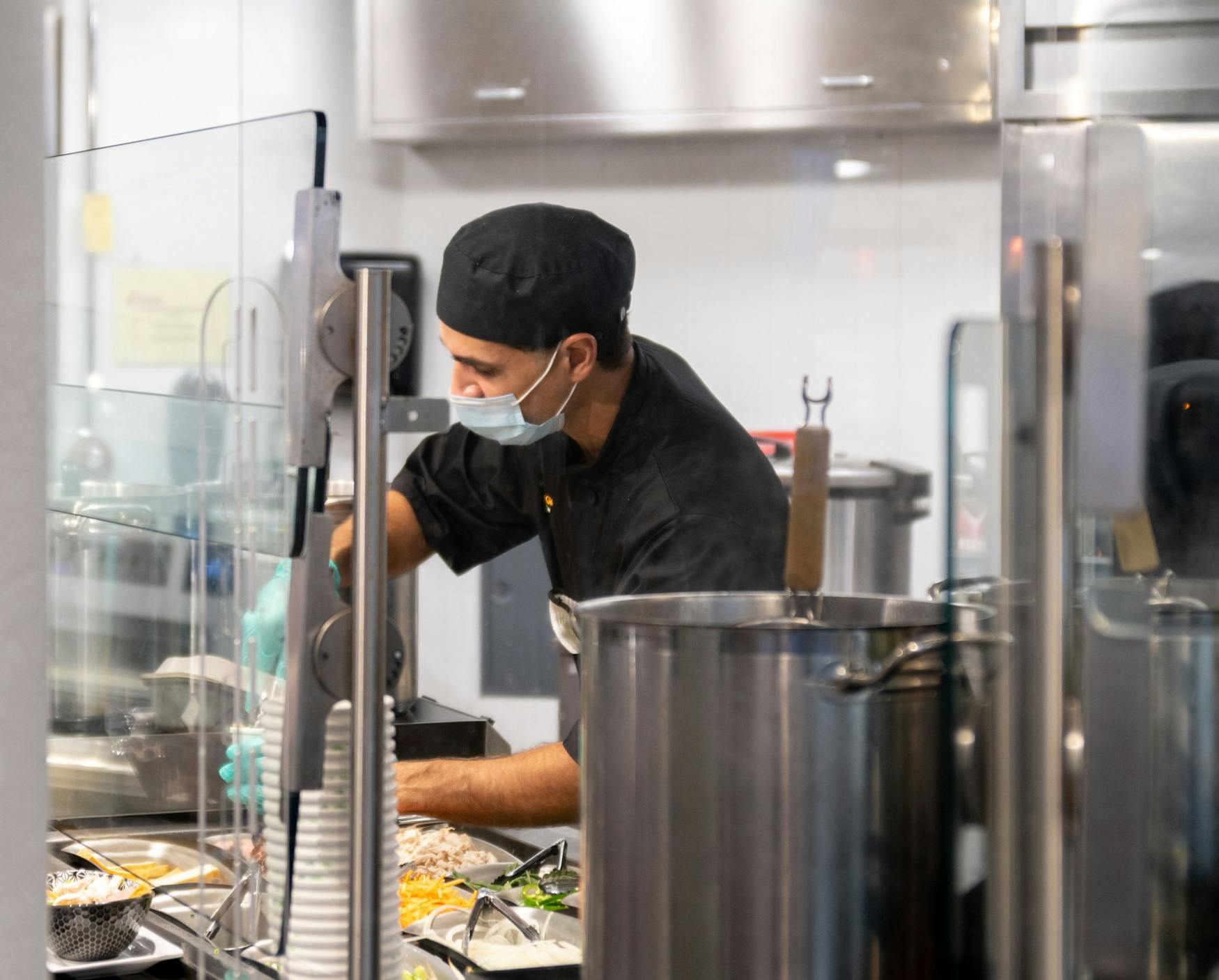Sodexo will continue its contract with the University until June 2022
COVID-19 stalled the Request For Proposals process, resulting in a new contract with Sodexo
Sodexo will continue to serve as the University’s food service vendor until June 2022, under a new contract that is currently being finalized. This new two-year contract is a departure from the University’s pre-pandemic plan to sign a longer-term contract following a Request for Proposals process, which would have potentially replaced Sodexo with one of three other dining contractors.
The University first announced that the RFP process has been suspended and that a two-year contract with Sodexo would be put in place in a short Aug. 6 BrandeisNOW article. The Justice spoke with Director of University Services Jeff Hershberger and Sodexo Resident District Manager Michael Reilly in a Sept. 17 interview to learn about the details of the new contract and the accompanying changes to the campus dining program this semester.
A new two-year contract with Sodexo
After campus closed in March due to COVID-19, “suspending the RFP happened fairly quickly,” Hershberger said. “We recognized early on that… we needed a known factor in the mix. There were so many unknowns with COVID-19. … This was one item that we could keep constant, and so the decision was made to stay with Sodexo.”
The original contract with Sodexo was slated to end on June 30 and be replaced with the contract developed from the RFP process. Having suspended the RFP process, the University signed an addendum to the existing Sodexo contract to continue dining services from March to August. The new two-year contract began on Sept. 1 and will run until June 30, 2022.
The Board of Trustees met in mid-September and approved the new contract. Although one section of the contract is still being developed, the body of the contract is done, Hershberger explained, and it should be officially signed soon. The contract will be signed by Executive Vice President for Finance and Administration Stewart Uretsky and Sodexo Senior Vice President of Operations Phil Harty.
The biggest difference between the two Sodexo contracts is the structure. The previous contract was a “profit and loss contract” and entailed a large capital investment from Sodexo, while the new contract is a “fee contract, so it’s the cost of the dining program plus a 5% management fee for Sodexo and there is no capital investment,” Hershberger explained. A Cini Little blog post explains that a profit and loss contract requires “the contractor to provide a foodservice program that they specify and control," while a management fee contract requires the dining contractor “to provide a foodservice program specified by the owner/client.”
The fee contract gives the University more control and flexibility over the dining program, because the University can decide what program elements and enhancements they want to pay for, Hershberger said.
The new contract was informed by community concerns, wants and needs raised during the RFP process. The RFP process began in mid-fall 2019 and worked to identify what campus community members wanted from the next dining contract. When it became clear that the University would not be able to complete the RFP process, Hershberger explained, “We said, ‘What is possible to carry over next year?’ And we tried to get as much as we could.” He added, “Even staying with Sodexo… we wanted there to be a marked difference in the program starting this fall, despite the COVID-19 challenges.”
Reilly added that many of the changes that Sodexo implemented for this semester followed ideas that the company had proposed during the RFP process.
Changes to the dining program this semester
What actually changed this semester with the new contract?
Many retail dining options and the stations within dining halls changed for fall semester. The stir-fry station in Lower Usdan was replaced by Lemongrass Kitchen, which features “authentic southeast Asian cuisine from celebrity chef and cookbook author Mai Pham,” per a presentation Hershberger provided to the Justice. Both dining halls now have Rustic Roots stations “dedicated to vegan and vegetarian students,” Reilly said. The Simple Serving stations, which serve dishes free from common allergens, were expanded in both dining halls.
In a Sept. 20 email to the Justice, outgoing Senate Dining Committee Chair Nancy Zhai ’22 highlighted the Rustic Roots and especially the Lemongrass Kitchen stations as changes that have received positive feedback from students.
To further support students with allergies and dietary restrictions, the new contract makes registered dietician Karen Jew a full-time Sodexo employee at Brandeis. She, along with Marketing Specialist Emily Baksa, previously worked on a variety of universities’ Sodexo accounts, but the two of them now focus solely on Brandeis under the new contract, Hershberger said. A summary document Hershberger provided to the Justice added that the University "will be hiring a food 'auditor' to regularly assess the accuracy of food labels, particularly with regard to allergen ingredients."
In Upper Usdan, a Sodexo house brand called Tres Habaneros replaced Curritos, which was not a Sodexo brand. Reilly explained that this change gave the dining program more “flexibility with menus” and “streamlined things” to allow for faster service. The change also made it possible for Sodexo to offer a meal-swipe payment option at the location, which should launch “within the next week,” Reilly said.

Unable to operate as a bar due to the pandemic circumstances, the Stein was reimagined to offer Boston-based Sal’s Pizza and be a Stein Express marketplace, selling the 150-200 most popular items from the Hoot Market, Reilly said.
One issue that students frequently raised with the previous contract was the meal plan structure and pricing. “We didn’t have the opportunity to change up the meal plan structure this time around,” Hershberger said, “but we did have the opportunity to address student concerns in regard to value on the block plan pricing.” Block plan prices dropped significantly from last year to this year — a 30% decrease for the 120 meal block plan and a 32% decrease for the 80 block plan, per Hershberger. These changes made block plan pricing “coincide with the per swipe price that students on traditional plans are paying,” he said.
Zhai, who was involved throughout the RFP process and works closely with dining services, praised the block plan price adjustment but said “more structural improvement needs to be made” to the meal plan structure to address student concerns.
Dining locations on campus now feature 40 new digital displays, Reilly said. These screens help welcome students to dining halls and share menu and promotional information. One benefit of the displays is to promote social distancing by making menu information easier to see from a distance.
Other changes to campus dining were made more directly in response to the pandemic. Sodexo's Bite University app is now available and allows for mobile ordering at eight campus dining locations, and the GET myID app allows for contactless “swiping in” to dining halls. Sodexo also expanded its e-commerce website, Grocery2Go, so students can order popular grocery items online.
Additionally, Brandeis dining implemented a massive number of changes to dining policies and infrastructure to promote social distancing and COVID-19 safety. Detailed on their Fall 2020 website, these changes include putting up plexiglass barriers, creating a one-way buffet line in dining halls, eliminating all self-serve options in dining halls, making dining entirely takeout service on disposable dinnerware and limiting seating in dining halls. There are also new, strict cleaning and sanitation protocols. Sodexo employees are provided with two masks each day, complete a daily health assessment and participate in the Brandeis COVID-19 testing program, according to Reilly.

These changes have been met with mixed levels of success and student satisfaction. Zhai praised the social distancing policies in dining halls and encouraged Brandeis dining to continue the new sanitation policies “even after the pandemic is over” to address “pre-pandemic concerns about sanitation.” Although Zhai said the GET contactless swipe for dining halls “has been well-received,” she highlighted issues students have faced with the Bite app, “like being overcharged and inconsistency with menus.” She added, “[The] Campus Card Office is working to reimburse students who were overcharged.”

Additionally, while new dining hall stations have expanded vegan and vegetarian options, students are still facing issues with allergen labeling and availability of gluten-free and plant-based options across locations, Zhai said, who made allergen safety and labeling a cornerstone of her dining work. She is working with Brandeis dining to address issues that have arisen with the Tres Habaneros and Rustic Roots menus, as well as quarantine dining. Some of these issues have already been addressed, she shared. She stressed the importance of Brandeis dining “stay[ing] consistent” with allergen sensitivity and labeling across dining outlets and amid program changes.
The future of the RFP process
Where do these changes leave the RFP process? “That is yet to be determined,” Hershberger said.
By March, those involved in the process had conducted months of work and narrowed the search down to four potential future dining contractors. The RFP process is technically suspended, but it is hard to predict what the future of the process will entail. The new selection process would likely start a year from now, but the ongoing pandemic means there is little certainty about where the University will be at that time. “I would find it hard to believe that we would start where we left off,” Hershberger said, explaining that the University’s expectations, contractors’ offerings and technology options will likely change.
During the initial RFP process, Brandeis Uprooted and Rising led a campaign that called on the University to transition to an in-house dining program, rather than signing a contract with any outside vendor. The RFP process did not make this option available, focused only on choosing who the new outside vendor should be.
In-house dining is “on the table” as an option for what could be enacted after this two-year contract ends, Hershberger said. The new fee contract structure is a key component of this because it strengthens the University’s understanding of running the dining program.
“A fee structure type contract gives the University a little more insight in regards to its own dining program. You know, ‘Why is Brandeis’ dining program so expensive? Why is it so complicated?’” Hershberger said. He added, “People like myself, [Vice President of Campus Operations] Lois Stanley, the Office of Procurement, we’re all much more involved, and the level of reporting is much more detailed. We know where every dollar is going in this contract. So we’ll come out of this with a firm understanding, that perhaps we didn’t have fully before, of what it means to run this type of dining program.”
“I do believe that that [in-house dining] will be one of the options and considerations on the table in the future,” he said.



Please note All comments are eligible for publication in The Justice.